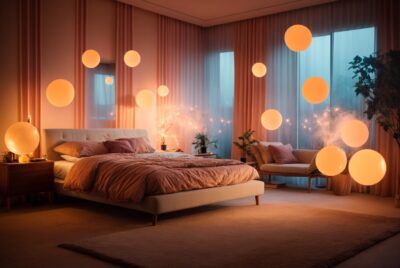Are you struggling to get a good night's sleep? Well, it might not just be your…
Low EMF Light Bulbs – Have You Got The Right Ones

If you’re trying to reduce devices in your home that emit EMF (Electromagnetic field), you probably think you will need to look at and replace items like your microwave or cell phone. It probably hasn’t crossed your mind that common everyday light bulbs that you have in every room of your house, actually produce a great deal of EMF radiation. Addressing the overhead lighting and other forms of artificial light by using different light bulbs can lower the EMF levels in your house.
EMF and light bulbs
Depending on the type of light bulbs you have, they can create EMF in a variety of ways. If you have a lot of WiFi-enabled devices in your home including some of the new smart bulbs which have WiFi capability, then you are likely to have higher EMF levels. Even smart bulbs with Bluetooth, can be equally dangerous in terms of radiation emissions.
Apart from the wi-fi, light bulbs can increase EMF levels by producing dirty electricity.
You’re probably thinking to yourself right now – what’s dirty electricity? And I hear you, as I hadn’t heard of it before now.
These new types of light bulbs use less electricity than the older incandescent light bulbs, which a lot of homes were wired for. They are very popular now because of the increase in energy efficiency, which is their unique selling point. Of course you want to follow green suggestions for improving the environment and reducing energy usage but you have to balance that with your overall health.
However, while these bulbs require less electricity, your home still sends the same amount of electricity pulsing through the wires. Some of this electricity that hasn’t been used returns back into your home’s wiring, and that creates what is called ‘dirty electricity.’ The problem with this dirty electricity is it emits a high level of EMF radiation which makes it dangerous.
You can measure dirty electricity using an EMF meter which you can purchase easily online. The way you check if you have a lot of dirty electricity is to take an EMF reading from the meter with all of your lights switched on and then take another reading with all of the lights switched off. If the numbers are higher with the lights on, then you know your light bulbs are creating dirty electricity in your home.
What are the safest light bulbs?
Believe it or not the, the old fashioned incandescent light bulbs are the safest light bulbs to use in terms of EMF production. The design of these bulbs took into account the electrical wiring that was already built into most homes, so they produce little to no dirty electricity. And because they don’t incorporate WiFi or Bluetooth you don’t have any EMF produced by these low EMF light bulbs.
You can buy incandescent EMF light bulbs quite cheaply although they aren’t as energy efficient or won’t last as long as other bulbs. One great option you can check out is by Sunlite. They sell a 40-pack of incandescent bulbs for a reasonable price and they are available by wattage. One pack of those will keep you lit up safely for a while.
Which light bulbs are best to avoid?
As much as it’s fashionable to have a smart home that you can control from your phone, avoiding smart light bulbs that use WiFi or Bluetooth can only improve your EMF levels. Most of these bulbs are usually LED-based and that leads to dirty electricity. Don’t forget that the wireless signals themselves produce their own EMF. If your goal is to reduce your overall EMF exposure, then it makes sense to definitely avoid these bulbs.
In fact you’ll want to avoid any type of bulb that produces dirty electricity. Fluorescent bulbs like LED bulbs(Light Emitting Diode) and the CFL light bulb(Compact Fluorescent Light) are known to do this. They weren’t designed for the best use of the electric current in our homes but for their low cost and low energy usage. This is why they tend to be the main lighting choice in workplaces and public buildings like schools and offices.
Unfortunately, most of the areas in our homes that require bright lighting like the kitchen and bathrooms tend to be designed with led bulbs.
Remote controlled light bulbs are another to add to your avoid list.You can buy them as light strips, or as a single light bulb. These bulbs often produce dirty electricity and the remote control emits EMF radiation.
Minimizing exposure
Minimizing your exposure is key to avoiding the harmful effects and health issues associated with EMF radiation. Lighting is a great place to start as changing light bulbs for the most part is something you can do yourself. Changing to incandescent bulbs where possible is a quick fix.
We know these are less energy efficient, but you can get your family involved in simply turning lights off when not in use. This can go a long way towards lowering your energy bill.
If you must use an LED bulb, smart bulb, or a CFL light bulb, use them as sparingly as possible. They do tend to be brighter and make you feel like it’s a more natural light, but like computer screens they produce blue light which can affect your sleep patterns and the CFL light bulbs also generate ultraviolet radiation.
You may have to get an electrician involved if you have overhead fluorescent light bulbs or built in led bulbs but it’s worth making the investment if you want to do all that’s possible to prevent any possibility of health problems in the future from any radiation.
If you can’t replace any of those bulbs to incandescent light then try and keep the offending lights away from nightstands, chairs, and other places where they might come into close contact with people.
Lowering your home’s overall EMF level can be difficult. Buying an EMF meter to measure your homes levels can help you track how successful your improvements have been. If you want the safest light in your home, other than natural light, switching to incandescent bulbs is one of your best options.



